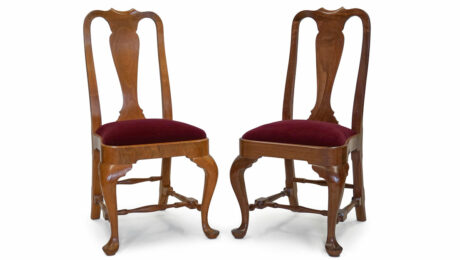Carving a Family Tree
Peter Follansbee provided the perfect project for some precious lumber John Mahoney retrieved from his father.
Creating these carved oak boxes has been a surprising journey. It has been filled with family memories and has provided me with many insights about working wood.
The story starts well before I was born. My dad grew up on a tree farm in Maine helping his father harvest trees for lumber and paper—Grandpa’s entire operation was done with horses. My parents settled in Utah to raise our family, but every summer during my childhood the family would make the trek back to the tree farm in the 1972 green-and-white Dodge van that my dad had converted to a homemade camper van with beds, curtains, and even a travel potty between the front seats.
Dad had caught the woodworking bug, and in the mid-1970s, he and Grandpa harvested a few trees for Dad to keep. My uncle, a log truck driver, hauled them to a sawmill to be cut into planks. Our van was always crowded on those cross-country trips, but that summer on the drive back to Utah the lumber was piled inside as well.
My dad made a few projects with the lumber, but it mostly stayed in a stack in his small basement shop. That was fine with me, since it was just the right height to be a child-size workbench where I would spend hours at a time hammering nails into scrap wood with my child-size tools.
Dad passed away when I was young, and the lumber remained largely untouched for the next 25 years. In the meantime, I graduated from college, moved to the St. Louis area, got married, and started filling my own basement shop and learning woodworking. About 10 years ago, my mother asked me to get the few planks remaining in her basement, so when I went to Utah for my niece’s wedding, I brought the lumber back to St. Louis in my Toyota Tacoma—also green but nowhere near as interesting as the Dodge van.
I decided to make something with the wood that I could share with my siblings, something that would relate to the history of the tree farm. I spent several years awaiting inspiration. Then I saw the articles by Peter Follansbee in Fine Woodworking #287 (“Simple, Handsome 17th-Century Box” and “17th-Century Relief Carving”) and found what I was looking for. I admired the elaborate carvings, and the box matched the time period of the original part of the Maine farmhouse, with its hand-hewn beams and stone foundation.
Peter’s carvings were very intimidating, but I set a goal to make eight boxes: for my four siblings, my mom, my aunt, my in-laws, and myself. Prior to this I had tried my hand at a few practice carvings and had become familiar with the tools, but I was definitely not proficient with them. Along the way I learned a few things.
The eye is amazingly accurate.
Peter does very little layout, relying instead on his eyes and the shape of his tools to incise a carving’s layout. He makes everything look easy, and I was skeptical I could work the same way. But I discovered that using a few layout lines and reference points, visually gauging the gaps, connecting imaginary dots, and using the shape and width of the gouges, I could get very accurate results.
The eye is quite forgiving.
In one of Peter’s videos, he was carving along when a large chip broke off. He just brushed it away and moved on. Later he mentioned that he never glues the chips back on; if you do, it looks worse than with the chip missing. The carvings are busy enough, he says, that you probably won’t notice missing chips. I expected to lose some chips, but I was still devastated when it happened. Ignoring Peter’s advice, I glued some of the chips back on. Sure enough, once I applied the finish, the glued-on chips were highlighted while missing chips blended in.
It’s not a race or competition.
In the videos I used for reference, Peter completes the carvings in about 30 minutes. On my first two boxes, similar carvings took me over a week. I have done better with my subsequent carvings, but they still require multiple days. I’ve realized, though, that the duration doesn’t matter, because I am learning, and having fun, and I’m pleased with the end result.
I still have more to learn, and four more boxes to complete. After that, who knows where the journey will take me?
John Mahoney is a software engineer in Godfrey, Ill. When not working or working wood, he can be found shredding trails on his mountain bike.




















Comments
Very nice project. Do all eight boxes have the same carving patterns? If not, how will you decide who gets which box?
Log in or create an account to post a comment.
Sign up Log in